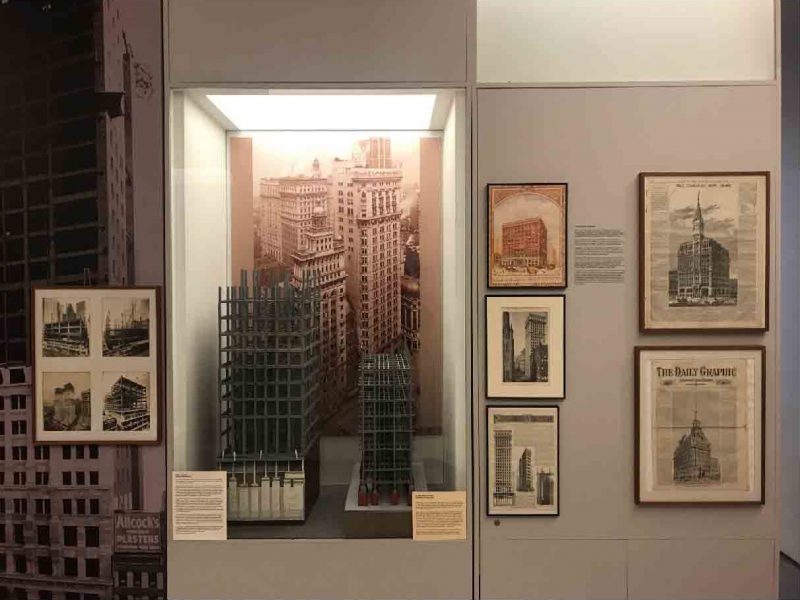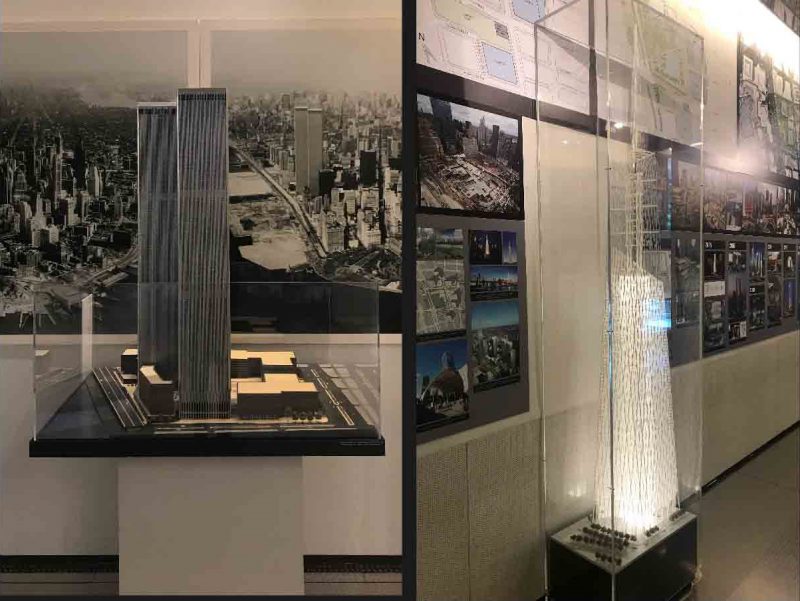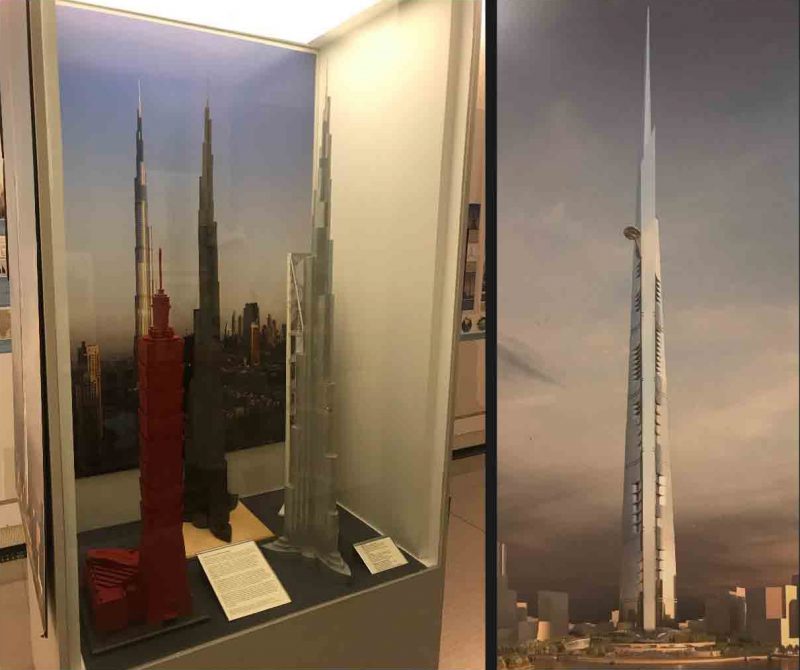
Permanent Exhibition
The Skyscraper Museum's permanent gallery features a 36-foot long mural that presents selected episodes in the history of height from the pyramids to the present, highlighting themes and buildings that relate to the evolution of the skyscraper and point the way to 21st-century supertalls. It examines the ambition to build high, the technological advances and engineering innovations that enabled that desire, the economics that drove commercial development, the influence of outstanding architectural designs, and the codes and regulations that shaped buildings and skylines.
On the top row is a lineup of the successive structures that held the title of "world's tallest building." On the lower range these are scaled in silhouettes that chart that ascent through the traditions of building in masonry, metal, and concrete, leading up to the first skyscrapers in New York and Chicago in the 1870s and 1880s. From the 270-foot New York Tribune Building to the 2,717-foot Burj Khalifa in Dubai is an astonishing tenfold rise, but the acme of size in terms of overall scale, rather than sheer height, came in the 1970s, with the twin towers of the World Trade Center and the Sears, now Willis, Tower.
The central timeline is illustrated with historical prints and photographs and text boxes that are color-coded: light blue labels describe buildings and events in New York City; green labels refer to Chicago; dark blue in the final panel refers to Asia.
History of Height
The Skyscraper Museum's permanent gallery features a 36-foot long mural that presents selected episodes in the history of height from the pyramids to the present, highlighting themes and buildings that relate to the evolution of the skyscraper and point the way to 21st-century supertalls. It examines the ambition to build high, the technological advances and engineering innovations that enabled that desire, the economics that drove commercial development, the influence of outstanding architectural designs, and the codes and regulations that shaped buildings and skylines.
On the top row is a lineup of the successive structures that held the title of "world's tallest building." On the lower range these are scaled in silhouettes that chart that ascent through the traditions of building in masonry, metal, and concrete, leading up to the first skyscrapers in New York and Chicago in the 1870s and 1880s. From the 270-foot New York Tribune Building to the 2,717-foot Burj Khalifa in Dubai is an astonishing tenfold rise, but the acme of size in terms of overall scale, rather than sheer height, came in the 1970s, with the twin towers of the World Trade Center and the Sears, now Willis, Tower.
The central timeline is illustrated with historical prints and photographs and text boxes that are color-coded: light blue labels describe buildings and events in New York City; green labels refer to Chicago; dark blue in the final panel refers to Asia.

First Skyscrapers/Steel Skeletons
At the time of its completion in 1908, the City Investing Building was the largest building in the world in terms of interior space -it took up almost an entire city block! The building also stood on the same block as the world's tallest building of the time -the Singer Tower. The block where the City Investing Building previously sat is now 1 Liberty Plaza.
This photographic image shows the City Investing Building construction site, built between 1906 and 1908. Visible are the structure's steel skeleton, workers balancing on I-beams, and cranes lifting many tons of building material hundreds of feet in the air.
The photograph hangs at the top of the Museum's entrance ramp, which is designed to feel like you are walking on the steel I-beams used in the construction of skyscrapers. As a family, walk up and down the ramp and imagine you are balancing on steel beams hundreds of feet in the air! Also try standing in front of one of the photographs and looking up into the mirrored ceiling. It's as though you're standing at the bottom of the construction site, looking at the new skyscraper reaching up into the clouds.
The Original World Trade Center and Rebuilding
Through several past exhibitions, such as WTC Monument and GIANTS: The Twin Towers and the Twentieth Century, The Skyscraper Museum has examined the history of the World Trade Center complex in its conception, design, and construction from the 1960s through the mid-1970s. The South Gallery features photographs, film, and models of the original World Trade Center.
Models of the original World Trade Center (left) and Freedom Tower (right).
This section of the permanent exhibition addresses both the history of the original Twin Towers and the rebuilding at Ground Zero over the decades after the tragic events of 9/11. This content is displayed as a timeline in the gallery’s south wall in a mural 29 feet wide by 11 feet tall wall and is stratified in three thematic zones as shown in the image below: Timeline, Construction Views, and Master Plans.
World Trade Center Rebuilding mural in the Museum's gallery.
Skylines
A skyline is a horizon interrupted by verticals. Seen from a distance, a city’s tall buildings make a collective, coherent image – a silhouette against the sky that creates an identity. Throughout history, cities have been distinguished by their prominent structures: Florence by the Duomo, Paris by the Eiffel Tower. New York is defined by its multiplicity of skyscrapers.
Manhattan grew a skyline before writers found a word for it. The earliest skyscrapers, office buildings of ten stories, rose near City Hall Park in 1874, but it was not until two decades later that a burst of towers of twenty stories, 300 feet or taller, truly transformed the city’s image. Located especially along the spine of Broadway from the Battery to Chambers Street, they composed a profile visible from both rivers. One critic mused in 1897: "it is in aggregation that the immense impressiveness lies. It is not an architectural vision, but it does, most tremendously, look like business!"
World's Tallest Models
The models of Burj Khalifa, Taipei 101, and Shanghai World Financial Center, all created at the same 1:500 scale, represent the three tallest buildings in the world in 2012. At 828 m/ 2717 ft., Burj Khalifa is the tallest manmade structure in every refereed category, which includes highest roof level or occupied floor; highest integral architectural feature; and highest additional structure/ antenna.
Burj Khalifa exceeds by more than one thousand feet the next tallest occupied building, Taipei 101. In other building categories-in particular TV and broadcasting towers, which often double as tourist sites-two new structures, Canton TV tower and Tokyo Sky Tree, recently topped out at heights of around 2,000 ft.
The red model of Taipei 101 is a wind-tunnel model, created to test the structural design and performance of the tower before it is constructed. Taipei 101, the tallest building in Taiwan, rises 509 m/ 1671 ft to the top of its slender ornamental spire.
The structural model of Shanghai World Financial Center was created by its designers at Leslie E. Robertson Associates to illustrate the skyscraper's structural system. Although the design of the tower was "drawn" and calculated by computers, the model was made to help clients and others visualize and understand the structural system of the frame, core, and outriggers. Shanghai World Financial Center measures 492 m/ 1614 ft to its tapered roof and highest observation deck. Of note: the circular opening in this early version of the tower was changed in the final design.
Supertall Wall
The Skyscraper Museum created the first Supertall Survey in 2007 in conjunction with its exhibition on the Burj Khalifa, then under construction in Dubai. At the time, 28 buildings worldwide met our criteria: a skyscraper of 380 meters / 1,250 feet or taller that was completed or under construction. We also included proposed projects that we believed would open within five years, the average time required to complete a building of supertall scale.
Four years later, in 2011, the Museum updated the original study in the exhibition SUPERTALL, eliminating five abandoned projects and adding 24 new ones. The supertalls of the 2011 survey are shown on the globe on the opposite wall, arranged by their geography. Then, new supertall activity was concentrated in China and Asia Pacific.
Regular surveys show that a significant percentage of proposals that sound real are not, in the end, realized. The 59 buildings in our 2018 survey, shown on our Supertall Wall and on the interactive screen, represent all the completed or active projects worldwide. Of those from 2011 forward the majority are in China, which now boasts half of the world’s supertalls. The Middle East remains the arena of the competition for the world’s tallest building.
The Supertall Survey has been recently updated in the exhibition SUPERTALL!2020.
Chesko Mini Models
The Museum's amazing mini-Manhattan models and their creator Michael Chesko are featured in this month's Wired Magazine's Design section. View dramatic photographs in the online article that juxtaposes New York models with other city models throughout the world, including the Shanghai Urban Planning Exhibition Center's model, which measures 6,500 square feet.
Two highly-detailed, hand-carved miniature wooden models of Downtown and Midtown Manhattan have been donated to The Skyscraper Museum by Arizona resident Mike Chesko, a 49-year-old retiree and devoted amateur model maker. In June, Chesko, his wife, son and niece drove cross-country to transport the precious panoramas to the museum and to see the real city at full scale. It was their first trip to New York.
Chesko's models measure 17-3/4 by 20 inches for the Lilliputian Lower Manhattan and 37 by 31 inches for Midtown. The scale of the model is 3/8 inch for every 100 feet, meaning that the 1,250 foot Empire State Building reaches only 4.7 inches tall. The tallest of the tiny buildings are the Twin Towers (still standing in this model) which soar a full 5.1 inches. These models are so small that ten city blocks can fit in the palm of your hand.









